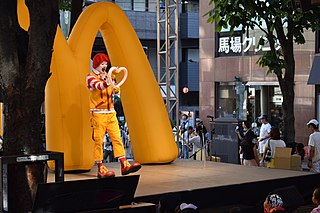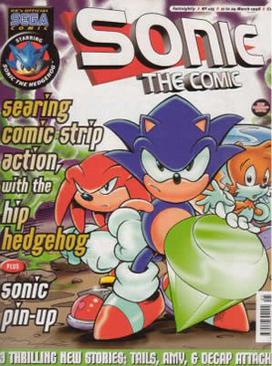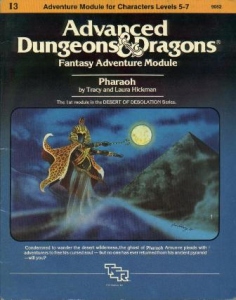Sources and external links
- Fansite, very detailed information (in German)
- Lurchi's adventures (official site of Salamander company) (in German) (some parts translated in English and other languages)
Lurchi is the advertising comic character of the German Salamander shoe factories. He is a fire salamander. His adventures are told (in German) in small booklets titled Lurchis Abenteuer (Lurchi's adventures). They are targeted mainly at primary schoolers, written in calligraphic handwriting in simple rhyming couplets.
While Salamander issued some newspaper advertisements featuring an anonymous anthropomorphic salamander in early 20th century, the character Lurchi was introduced in 1937. The name of the artist of the pre-war booklets is lost.
In the 1930s, Salamander did not even produce children's shoes. The booklets were rather meant to keep youngsters quiet while parents would buy shoes.
Lurchi's adventures ceased publication in 1939 due to the outbreak of World War II. They were continued only in 1951, starting with redrawn remakes of the prewar issues 1–5. Then, artist Heinz Schubel and writer Erwin Kühlewein took over, and shaped the style of Lurchi as it became known by generations of readers. Schubel retired in 1972, and various artists tried to keep up his standards - unsuccessfully, in the opinion of the majority of fans. In 1995 Dietwald Doblies took over and returned to a more "Schubelian" style.
In 2000, all protagonists of the series underwent a major "brushup" at the request of the company's management. Most remarkably, they became fully clothed, whereas in their classic form they had been mostly nude except for some accessories, and, of course, their Salamander shoes. It should be mentioned, however, that the "mammal" protagonists (the mouse, the hedgehog and the dwarf) always had worn at least pants, and the amphibian protagonists of course had no visible reproductive organs. But more essential to the series was the change of roles the protagonists went through (e. g. Piping had been the group's elder before, since 2000 he is a child). Moreover, the text is in prose now.
Five friends help Lurchi in his adventures:
Lurchi has met these friends during issues 1 to 5.
In the first issues (~1-3) Lurchi was still basically a salamander, very "humanized" in form, but in its natural size and confronted with nature life dangers such as predators (stork, hedgehog, owl) etc. In these issues he is also clearly an adolescent, living with his parents, whereas in later stories he acts independently and is practically "ageless". Soon Lurchi's world developed into a fictional pseudo-human society of small creatures (animals and dwarfs) who had cars and other technology fitting their size, but still lived in mushroom and trees trunk houses (~issues 4–10, and once again in issue 22 "The Olympiad"). In the "classic" era, Lurchi and his friends were anthropomorphic animals only slightly smaller than humans, and travelled the human world.
Many adventures include exotic places, fairytales and sporting competitions. In the 1973-95 period, "political correct" subjects were preferred, mainly environment related.
The adventures always have a happy ending, thanks to the (sometimes unconventional) use of Salamander shoes. They always end with the rhyme:
"Im … tönts lange noch
Salamander lebe hoch!"
"In … it's heard long after
Long live Salamander!",
where XXX is the name of the current adventure's scene.
Some audio plays have been produced: at least five episodes on Flexi disc in the 1960s, at least three on vinyl single disc around 1970, six on Compact Cassette in the early 1990s, and a running series on CD since 2000.
Very popular were the toy figures: Lurchi as an articulated figure (rubber with intern metal wire), the six friends as rubber figurines (with squeaking valve), and the six friends as large (around 1 ft) articulated plastic figures. There have been some smaller and less popular series of figures. After 2000, the classic figure series were discontinued and replaced by hard plastic figures of the "new" characters.
There are many other (but mostly short-lived) merchandising articles, including colouring books, plush toys, stickers, postcards, jumping jack Lurchi, and, in the shoe shops, rockinghorses and small merry-go-rounds.

The Mickey Mouse universe is a fictional shared universe which is the setting for stories involving Disney cartoon characters, including Mickey and Minnie Mouse, Donald and Daisy Duck, Pluto and Goofy as the primary members, and many other characters related to them, being most of them anthropomorphic animals. The universe originated from the Mickey Mouse animated short films produced by Disney starting in 1928, although its first consistent version was created by Floyd Gottfredson in the Mickey Mouse newspaper comic strip. Real-world versions also exist in Disneyland and Tokyo Disneyland, called Mickey's Toontown.

McDonaldland is a McDonald's media franchise and the fictional fantasy world inhabited by Ronald McDonald and his friends. Starting with the creation of Ronald McDonald in 1963, it is primarily developed and published by McDonald's. Initial attempts to expand the McDonaldland universe by marketing agency Needham, Harper & Steers were seemingly retconned due to legal issues, but ongoing aspects were expanded in McDonald's projects in collaboration with Data East, Virgin Interactive, Treasure, SEGA, and Klasky Csupo.

Shadow the Hedgehog is a character who appears in Sega's Sonic the Hedgehog franchise. He was created by Takashi Iizuka and Shiro Maekawa, designed by Kazuyuki Hoshino, and first appeared in Sonic Adventure 2 (2001).

Sonic the Hedgehog is an American comic book series published by Archie Comics, in partnership with Sega. Although this continuity was based on Sega's video game franchise, it had much more in nature with the American 1993 animated series of the same name. After initially beginning with a four-issue miniseries from February to May 1993, the first full-length issue of the comic was published in July 1993. The series ran for 290 issues for over 20 years, earning a place in the 2008 Guinness World Records for being the "longest-running comic series based on a video game" in U.S. history.. It became the longest-running franchise-based comic series in 2015 before it was confirmed cancelled in July 2017, following Sega and Archie Comics' decision to discontinue their business relationship. The series features a cast of hundreds of characters, consisting of both those derived from the Sonic games and those original to the comics, with stories focused on a crime-fighting organization called the Freedom Fighters, led by Sonic, as they face off against series antagonist Doctor Eggman alongside a variety of other villains.

Sonic the Comic was a British children's comic published by Fleetway Editions between 1993 and 2002. It was the UK's Sega comic, featuring stories about its mascot Sonic the Hedgehog and related characters, as well as comic strips based on other Sega video games, along with news, reviews, and tips for games released for Sega systems.

Buster Brown is a comic-strip character created in 1902 by Richard F. Outcault. Adopted as the mascot of the Brown Shoe Company in 1904, Buster Brown, along with Mary Jane, and with his dog Tige, became well known to the American public in the early 20th century; the character's name was applied to a popular style of suit for young boys, the Buster Brown suit, that reflected his outfit.

Flying Rhino Junior High is a fantasy animated television series produced by Neurones Animation, Nelvana Limited, and Scottish Television Enterprises. The show was originally aired from 3 October 1998 until 22 January 2000 on Teletoon in Canada. In the United States, the show aired on CBS. On 2 February 2000, the show was cancelled.

The fox appears in the folklore of many cultures, but especially European and East Asian, as a figure of cunning, trickery, or as a familiar animal possessed of magic powers, and sometimes associated with transformation. Literature, film, television, games, music, and other forms of cultural expression may reflect the folklore image and reputation.

Koziołek Matołek is a fictional character created by Kornel Makuszyński (story) and Marian Walentynowicz (art) in one of the first and most famous Polish comics back in 1933. It became a cult classic, popular since its creation till today, and becoming an important part of the canon of Polish children's literature.

Desert of Desolation is a compilation adventure module published by TSR for the Dungeons & Dragons (D&D) fantasy roleplaying game. It combines three previously published individual modules: Pharaoh, Oasis of the White Palm, and Lost Tomb of Martek. The modules were made for use with the first edition Advanced Dungeons & Dragons (AD&D) rules. Pharaoh was created by Tracy and Laura Hickman soon after the couple married in 1977, and published by TSR in 1982. Oasis of the White Palm was a collaboration between Tracy Hickman and Philip Meyers, and Hickman wrote the Lost Tomb of Martek on his own; both were printed in 1983.

Rubber hose animation was the first animation style that became standardized in the American animation field. The defining feature is a curving motion that most animated objects possess, resembling the motion and physical properties of a rubber hose. While the style fell out of fashion by the mid-1930s, it has seen a renewed interest since the 2010s.

Sibylline is a Belgian comics series by Raymond Macherot and his second best-known work after Chlorophylle. Just like the latter, it is a fantasy comic about anthropomorphic animals in a forest setting. However, here the protagonist is a female mouse named Sibylline.

Doctor Ivo"Eggman"Robotnik is a character created by the Japanese game designer Naoto Ohshima. He is the main antagonist of Sega's Sonic the Hedgehog franchise. Eggman is a mad scientist who seeks to steal the mystical Chaos Emeralds, defeat Sonic the Hedgehog, and conquer the world. Eggman and his "Badnik" brand of military robots serve as bosses and enemies in the Sonic platform games. His distinctive characteristics include his red-black-yellow clothing, baldness, pince-nez sunglasses, and large mustache.
JumpStart 3D Virtual World was a sub-series of the larger JumpStart series of educational games. It was originally titled JumpStart World. In 2018, it was followed by JumpStart Academy.

Once Upon a Time... Man is an educational animated television series created and directed by Albert Barillé. It is the first series in the Once Upon a Time... franchise. It explains human history in a format adapted for children, with the action focused around one group of characters which appear in every episode dealing with the problems of the period depicted. Although historical figures would typically appear as themselves, occasionally they inherit the appearance and some of the personality of one of the archetypes. The series is known for explaining historic events to children from different viewpoints as the main characters come from different civilizations.

Cococinel was a French-Belgian children's television cartoon. Directed by Raymond Burlet and written by Yolande Baillet and Jean Montagné, 78 episodes of the animated cartoon were made in 1992, divided into 2 seasons The main character is a ladybird who has a magic four-leaf clover with incredible powers, it made her strong and thanks of this Cococinel defends her forest city called Cocoland from terrible threats. Also some times, aided by her friends, she teaches about ecology and the environment.

Hey Duggee is a British pre-school children's animated television series aimed at two to five-year-olds. Created by Grant Orchard, it is produced by Studio AKA, in association with BBC Studios. The show is narrated by Alexander Armstrong.

Summer Camp Island is an animated television series created by Julia Pott for Cartoon Network. Produced by Cartoon Network Studios, it premiered on July 7, 2018. The series depicts the episodic adventures of Oscar and Hedgehog, both of whom are staying at the magical eponymous summer camp. The show premiered with a 48-hour marathon consisting of the first 20 episodes running over an entire weekend, on both Cartoon Network and Boomerang. Another 20 episodes premiered on June 23, 2019, as the second half of the first season.